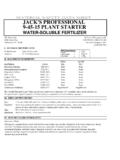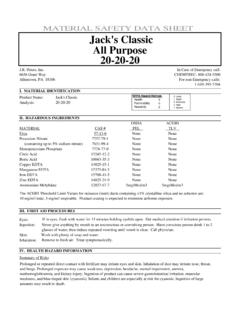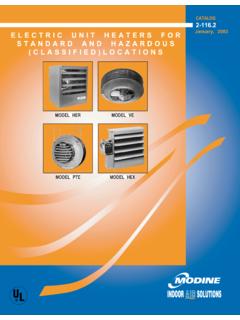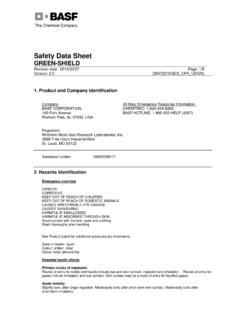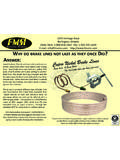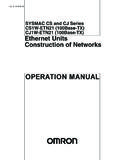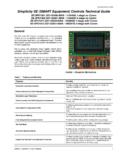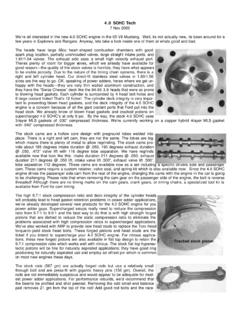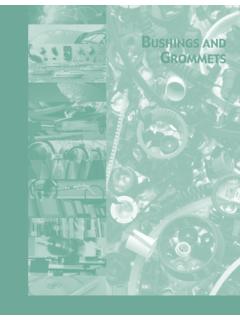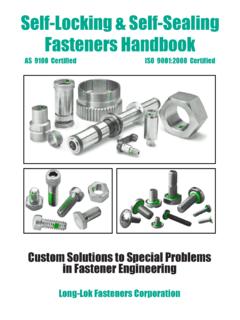Transcription of Multi Multi----wall Polycarbonate Installation ...
1 Multi -wall Polycarbonate sheet can be used on both gable and arched style green-houses. These easy to install panels can be attached directly to the greenhouse frame using one of several suggested fas-tener methods. Multi -wall Polycarbonate sheets can re-place existing greenhouse coverings includ-ing double polyethylene, fiberglass or glass. The following information provides an overview of the proper Installation pro-cedure. Bending/BuryingBending/BuryingBending/Bu ryingBending/Burying Multi -wall Polycarbonate is sufficiently flexi-ble to allow moderate curves. The mini-mum cold forming radius is 24 for 6 mm thickness, 31 for 8 mm thickness and 94 for 16 mm thick material. Flexing or in-stalling a sheet to the point of buckling can cause rapid deterioration in highly stressed areas. For added strength and rodent control, sheets at ground level may be buried 4 to 6 . PositioningPositioningPositioningPositio ning Sheets must be installed with the ribs run-ning vertically and the bottom edge un-sealed to assist condensed water vapor drainage.
2 This allows moisture to escape freely and prevents algae growth. SealingSealingSealingSealing Always seal top of Multi -wall Polycarbonate sheet to protect dirt and dust from entering the channels. Use 1 wide foil tape to seal channels. Always seal bottom of Multi -wall polycar-bonate sheet to protect dirt, dust and in-sects from entering the channels. Use spe-cial 1 anti-dust tape which allows chan-nels to breathe. Multi Multi Multi Multi ----wall Polycarbonate Installation Instructionswall Polycarbonate Installation Instructionswall Polycarbonate Installation Instructionswall Polycarbonate Installation Instructions Bending/BuryingBending/BuryingBending/Bu ryingBending/Burying PositioningPositioningPositioningPositio ning SealingSealingSealingSealing Available AccessoriesAvailable AccessoriesAvailable AccessoriesAvailable Accessories Ridge SealingRidge SealingRidge SealingRidge Sealing CCCC uttinguttinguttingutting Multi -wall Polycarbonate sheet can be cut with a variety of common hand-held and table-mounted equipment.
3 In general, sharp tooling with fine cutting teeth should be used to mini-mize vibration and chatter. Sheets should be properly supported along the trim line before cutting. Circular SawsCircular SawsCircular SawsCircular Saws Use a fine-tooth, hollow ground panel blade with 10-12 teeth per inch. Saber SawsSaber SawsSaber SawsSaber Saws Saber saws equipped with a fine-tooth blade can also be used, but proper support is recom-mended. DrillingDrillingDrillingDrilling Drill with a high-speed steel or carbide tipped twist drill. Drill holes slightly larger than the fas-tener to allow for expansion and contraction. ( , drill a 1/4 hole for a 3/16 screw). Place holes at twice the fastener diameter or 1/2 from the edge of the sheet, whichever is greater. AccessoriesAccessoriesAccessoriesAccesso ries A number of different accessories are available to simplify the Installation of Multi -wall polycar-bonate sheeting. Self-drilling, self-tapping screws with neoprene washers are for alumi-num or steel substructures; woodgrip screws are for wood substructures SealingSealingSealingSealing To seal the pitched roof ridge from the ele-ments, a ridge cap may be formed from alumi-num or other suitable material.
4 The ridge cap should be sealed with foam weatherseal. It is recommended that a minimum 3:12 pitch roof be maintained. Foamed closures may be used at the ridge peak and other locations to seal the greenhouse. Closures should have a profile and be made of materials compatible with Corrugated Polycar-bonate Sheet. Use a high quality, compatible sealant such as silicone rubber to seal holes or overlaps. TTTT hermal Expansionhermal Expansionhermal Expansionhermal Expansion Allow for thermal expansion during installa-tion at a rate of 1/8 per 3 feet at 100 F. temperature. Allow for this difference in both width and length of sheet. Glazing sys-tem should not inhibit the expansion of poly-carbonate panel in either direction. PPPP oint Fasteningoint Fasteningoint Fasteningoint Fastening Multi -wall Polycarbonate should be fastened to the greenhouse substructure in accor-dance with the spacing shown in the dia-grams above. Multi -wall Polycarbonate can be fastened di-rectly to a wooden or metal greenhouse sub-structure.
5 The screws used to fasten Multi -wall Polycar-bonate should have neoprene or EPDM washers. Ensure that the washer does not crush the Polycarbonate panel. It is recommended to use a no-drip spacer washer made of neoprene positioned be-tween the Multi -wall Polycarbonate sheet and the building structure. Fastening to Building StructureFastening to Building StructureFastening to Building StructureFastening to Building Structure Spacer WasherSpacer WasherSpacer WasherSpacer Washer AAAA luminum Glazing Systemluminum Glazing Systemluminum Glazing Systemluminum Glazing System Multi -wall Polycarbonate can be fastened to the greenhouse and joined to adjoining panels by utiliz-ing an aluminum glazing system. The individual components work as a unit to secure the panel to the structure and to seal the structure from the elements. EEEEnd Capnd Capnd Capnd Cap Used to seal tops, bot-toms and sides of panels. Bar and CapBar and CapBar and CapBar and Cap Used to join adjacent panels.
6 Ridge ExtrusionRidge ExtrusionRidge ExtrusionRidge Extrusion----Used at peak of gable style roof. Gable ExtrusionGable ExtrusionGable ExtrusionGable Extrusion----Used to join roof & end wall panels at gable. Corner ExtrusionCorner ExtrusionCorner ExtrusionCorner Extrusion----Used to join side wall & end wall panels at corner MATERIAL 15 PSF LOADING 30 PSF LOADING 45 PSF LOADING 8mm x 6 Wide 36 26 12 16mm x 6 Wide 60 40 36 8mm x 4 Wide 38 28 18 Purlin & Girt SpacingPurlin & Girt SpacingPurlin & Girt SpacingPurlin & Girt Spacing Recommended Loading (Maximum Purlin Spacing) 1 DeflectionRecommended Loading (Maximum Purlin Spacing) 1 DeflectionRecommended Loading (Maximum Purlin Spacing) 1 DeflectionRecommended Loading (Maximum Purlin Spacing) 1 Deflection



